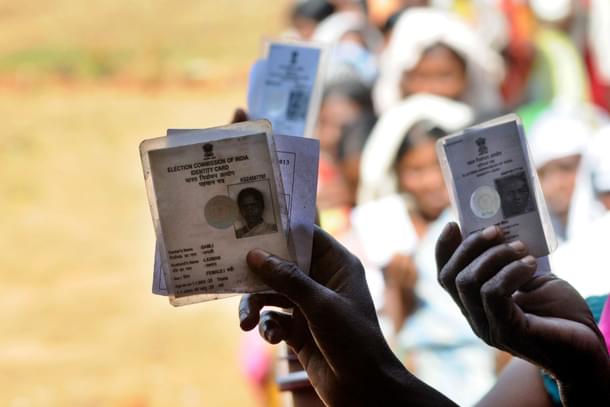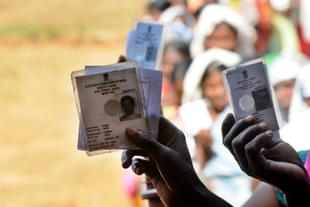Politics
Women Voters: The Real 'XX' Factor In This UP Election
Anand Lakshman
Mar 21, 2022, 05:22 PM | Updated 05:22 PM IST
Save & read from anywhere!
Bookmark stories for easy access on any device or the Swarajya app.


‘Baba Bulldozer’. The images of BJP workers riding inside the mouth of earth mover's blades, broadcast on TV last week, looked like images from a citizens’ coup of sorts. A lot of analysis time of experts has been spent on dissecting which precise factors were responsible to catapult the Bharatiya Janata Party (BJP) back into office in Lucknow?
Was it Modi’s ever growing trusted benevolent leader image or was it Yogi’s “no nonsense” strict dictatorial policing that won the day for the BJP? Or was it simply the caste and communal calculus that both sides theorised and executed, seat by seat, region by region and turncoat leader by turncoat leader. The answer of course is multi-layered and complex; it is all of that and more. Yet the analysis can be narrowed down to one real 'XX-factor' in this election, which probably will set the tone for many more elections to come.
Looking at the macro level vote share data, the BJP won 41.3 per cent of the vote with a few more percentage points being contributed by its allies Apna Dal (Sonelal) and Nirbal Indian Shoshit Hamara Aam Dal (NISHAD Party).
The Samajwadi Party (SP), in contrast, won about 32.1 per cent of the vote, with its partner the Rashtriya Lok Dal (RLD) winning 2.9 per cent and other allies such as the SBSP (Suheldev Bharatiya Samaj Party), Mahan Dal, and Apna Dal (Kamerwadi) contributing their bit, just as with the BJP allies.
So what can explain the 6 odd percentage points difference between the BJP+ and the SP+? The India Today- Axis My India post poll survey as well as the CSDS Lokniti post poll surveys indicate that while the difference amongst male voters of their preferred choice between BJP and SP was only 4 per cent - 5 per cent (Axis My India- CSDS Lokniti), women voters preferred the BJP over the SP by 13 per cent -16 per cent (CSDS- Axis My India).
Women in India are pressing the EVM button with greater gusto and in larger numbers than ever before. In the 1960s-70s, the gap between the proportion of women voters who voted and the men who exercised their franchise was about 10 per cent, with the men leading the way. It has narrowed down gradually over time and by 2014, the difference in turnout by gender was only 1.8 per cent.
In UP 2022, 62.2 per cent of women (63.4 per cent in 2017) voted while only 59.6 per cent of men on the electoral rolls voted (59.2 per cent in 2017). However, there are only 868 women per 1,000 men on the electoral rolls in UP currently. This is an improvement from 857 per 1,000 before the revision of the rolls with 28.86 lakh women getting their names registered as compared to 23.92 lakh men between November & December 2021.
The poor ratio reflected on the voter list is because of skewed sex ratio to begin which gets accentuated over time due to lower enrollment of women. However, the special voter registration drives of the Election Commission are gradually filling the gender gap.
Psephologists conducting exit polls or post poll surveys have been reporting that their predictions are going off the hook because their sampled populations have an over representation of men (75 per cent to 88 per cent of respondents, Axis My India – CSDS Lokniti) and hence the actual turnouts are altering the results, even if ever so slightly.
A lot has been written about the caste combinations and the communal divide in Uttar Pradesh but very little insight is available as to how women are differentially voting as compared to their men in these patriarchal settings. Increased mobile phone penetration has led to women being exposed to messaging directly from their peers and other socio-political mobilisers, via Whatsapp or Facebook.
In the past, political opinion was the preserve of the male member of the family, usually the head of the family who would influence the women to vote on caste, communal or political affiliations. Now women can go out on polling day and express their choice, without necessarily agreeing with their male counterparts. Exit Poll surveyors have reported being confided in by women respondents about their choice and asked to keep it secret from other members of the household.
Of the approximately 80 lakh plus vote difference between the BJP+ and the SP+ (about 3.7 crore for BJP versus 2.9 crore for the SP), the estimated additional votes from men are only about 20 lakh, whereas nearly 60 lakh additional women voters have favoured the BJP alliance.
It would be interesting to analyse the post poll survey data to estimate the proportion of women voters amongst Muslims and Yadavs, who would have secretly voted for the BJP alliance in this election.
This begs the question as to why the Priyanka Gandhi Vadra’s ‘Ladki hoon lad sakti hoon’ war cry didn’t make even a miniscule dent on the vote share of women. The answer is simple; women are influenced more by welfare schemes that directly impact them rather than the gender of the leader or the promise of a share in power. By that measure the Congress wasn’t anywhere in the picture to get them something tangible, rather than the intangible benefits of fighting for power.
This is by no means to suggest that women are a homogenous vote bank and that irrespective of their individual caste or religion, they can be nurtured and influenced to vote in a unidirectional manner. However, their silent vote is increasingly influenced more by how many benefits have directly reached them or will make their lives less dreary, rather than by caste equations or communal considerations which influence their male counterparts.
While the men meanwhile are looking at how a share in the political power can be obtained, the women are looking at how they can lead better lives, and in-spite of all the caste and communal influences, women will vote in larger numbers for the party who they see ease their burden.
Representation of women in the assembly in Uttar Pradesh, a state which gave India’s first women Chief Minister, Sucheta Kriplani (1963-1967), has remained poor for long. The state elected 11 women members to its first assembly (1952-57) while the outgoing assembly had 44 members (out of 403), and the recent results have only thrown up 34 winners (25 BJP+, 8 SP+, 1 Congress).
Notably, representation in the cabinet is equally poor with just about one woman in 20 ministers in the last cabinet. This may not change anytime soon as the common woman is neither in a position to bargain for more power nor interested in obtaining their rightful share.
Women as a vote bank or a distinct entity, outside of the complex machinations of caste or religion, will start to become a key focus of campaign strategies in the near future. This concept will need further analyses and discussions. It is possible that women, as they gain further political voice, will demand more than just benefits that ease their daily lives. They will demand for a share of power and adequate representation.
The Women’s Reservation Bill, which has been in cold storage since 2010, and has not been touched by the BJP will need to be revived, discussed, debated and acted upon. But that is still some distance away. For now, governments will have to ensure the last mile delivery of welfare schemes, which touch the everyday lives of women, improving them qualitatively.
They will also have to ensure law and order, which makes women feel safe, to be themselves in public spaces and at any time of the day, just as the men in their families. These, along with ever increasing influence of social media and the comfort of the secret ballot, will ensure that women vote for what impacts them without fear of patriarchal oversight or influence. Political parties have to fall in line or perish.
Dr Anand Lakshman is a public health entrepreneur and the founder-CEO of AddressHealth.





